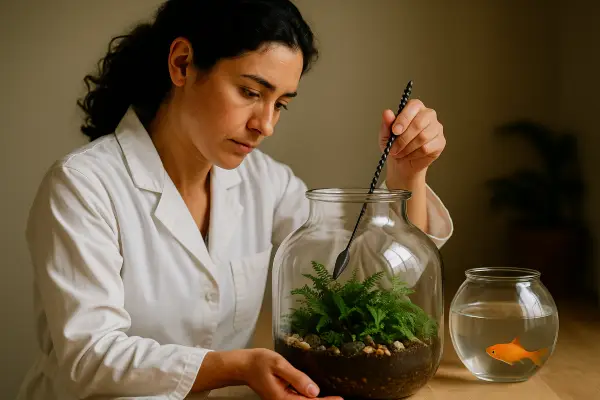Learning how to aerate a terrarium properly transforms struggling miniature ecosystems into thriving botanical showcases. Many terrarium enthusiasts find themselves puzzled when their carefully curated glass gardens develop condensation problems, stunted plant growth, or unwanted mold despite their best intentions.
Behind every successful terrarium lies a delicate balance of moisture, light, and crucially—proper air circulation. Understanding aeration helps us recreate the natural breathing patterns that forest floors experience through gentle breezes and seasonal temperature changes.
How to aerate a terrarium?
Terrarium aeration involves creating proper air circulation through strategic ventilation techniques, including the placement of vents and air holes, as well as managing humidity levels to prevent stagnant conditions that lead to mold growth and plant stress. Whether you’re working with a closed tropical ecosystem or an open desert display, the principles remain consistent: fresh air must flow in while stale air escapes.

Understanding terrarium air circulation needs
Air exchange occurs naturally when gases diffuse and expand to fill their container, but terrariums require deliberate ventilation planning to prevent stagnant conditions. Different terrarium types demand varying approaches to aeration. Closed terrariums need careful humidity management, while open terrariums require attention to both air movement and moisture retention.
Tropical plants such as ferns, moss, and fittonia thrive in high humidity levels between 60% and 90%, while succulents and cacti prefer dry conditions with humidity around 30% to 50%. This fundamental difference shapes your aeration strategy from the ground up.
Ventilation methods for improved air flow
Passive ventilation techniques
Effective ventilation starts with ensuring that all vents and air holes remain open and clear, allowing fresh air to enter the terrarium while stagnant air escapes naturally. For closed terrariums, consider these approaches:
- Strategic lid modification: Use aluminum or nylon screen material to cover ventilation holes, providing air exchange while preventing escapes.
- Variable vent sizing: Adjust vent width using cut glass pieces to control airflow while maintaining adequate circulation.
- Multi-level ventilation: Position lower intake vents near the front with upper exhaust points toward the back, creating natural convection currents.
Active ventilation systems
The gentle airflow from mini fans effectively prevents condensation and diminishes stagnant fog while providing continuous fresh air supply to plants and maintaining optimal humidity levels. Modern active systems include:
- Computer fans: Small 40mm computer fans can be modified to run on reduced voltage for subtle, continuous air movement without dramatic humidity drops.
- USB-powered fans: Low-voltage fans operating at 5V provide subtle air movement that prevents stagnation without stressing plants or dramatically altering environmental conditions.
- Timer-controlled systems: Connecting ventilation systems to timers allows remote control of air movement and can mimic natural humidity cycles.
Soil aeration techniques
Beyond air circulation, proper substrate aeration ensures root health and prevents anaerobic conditions that promote harmful bacteria growth.
Substrate composition for optimal aeration
Well-balanced terrarium substrates require drainage, aeration, and water retention properties achieved through mixing organic materials like coco coir with structural elements such as orchid bark and sand. Key components include:
- Coco coir base: Provides excellent root aeration and moisture retention while remaining light and fluffy without compacting over time.
- Orchid bark: Increases aeration within the substrate and helps maintain appropriate moisture levels while providing structural support.
- Perlite or sand: These additives allow drainage within the substrate mix and prevent water from becoming trapped, which could cause plant rot.
Manual soil aeration practices
Monthly soil aeration using gentle tools like chopsticks or unsharpened pencils helps maintain oxygen levels in potted plant root zones without causing excessive root damage. For established terrariums:
- Timing: Aerate soil monthly before watering sessions to maximize oxygen transport throughout the root system.
- Technique: Insert aerating tools every few inches around plants, creating small channels for air and water movement
- Depth: Work carefully around root zones, accepting that some minor root disturbance benefits overall plant health
Managing humidity through aeration
Proper ventilation creates an environment with balanced humidity levels by improving air circulation through opening vents, using dehumidifiers or fans, and avoiding overwatering. Humidity management requires understanding your plants’ specific needs:
For high-humidity tropical terrariums:
- Use controlled exhaust fans during peak condensation periods
- Run fans on interval timers, allowing humidity to rebuild between cycles while preventing excessive moisture buildup.
- Monitor with digital hygrometers for precise environmental control
For moderate-humidity environments:
- Provide adequate air circulation through vented glass containers or partially open designs to prevent excess moisture buildup.
- Balance fresh air intake with moisture conservation needs
- Adjust ventilation seasonally as ambient conditions change
Preventing common aeration problems
Mold and bacterial issues
Maintaining proper ventilation and cleanliness prevents mold, fungus, and bacterial infections while algal blooms can be controlled by ensuring adequate air circulation. Prevention strategies include:
- Regular cleaning of ventilation paths
- Keeping vents and air holes open and clear to allow fresh air flow through the terrarium, creating conditions less conducive to harmful microorganism growth.
- Immediate removal of decaying organic matter
Overheating prevention
Preventing overheating involves improving ventilation, managing plant growth, and creating shaded areas within the terrarium environment. Implement these cooling strategies:
- Position mini fans to alleviate temperature buildup, especially when using higher-powered heat sources or during hot summer conditions.
- Prune overgrown vegetation that restricts airflow
- Create strategic shade zones using taller plants or decorative elements
Monitoring and adjusting aeration systems
Monitor your habitat by watching for signs of insufficient or excessive ventilation, including plant wilting from humidity drops or stagnant air conditions. Key indicators include:
- Excessive condensation: Increase ventilation gradually
- Plant wilting: Reduce air circulation to maintain humidity
- Slow plant growth: Check for both over- and under-aeration
- Unpleasant odors: Increase air exchange immediately
Regular monitoring with hygrometers and thermometers helps maintain optimal conditions. Adjust three interconnected parameters: heat provision, water addition rate, and air exchange volume to achieve desired temperature and humidity levels.
Conclusion
Last month, while troubleshooting a client’s struggling closed terrarium filled with delicate ferns, I realized the power of proper aeration techniques. The previously stagnant environment transformed within weeks after installing a simple USB fan system and adjusting the substrate composition. Watching those ferns unfurl new fronds reminded me why I fell in love with these miniature ecosystems—they teach us that even the smallest environments require thoughtful engineering to thrive. This article reflects years of experimentation and countless terrarium rescues, proving that proper aeration turns struggling glass gardens into flourishing botanical masterpieces.
